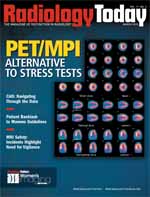 March 2010
March 2010
PACS PLATFORM
Quality Assurance in the Digital Age
By Leslie C. Jenkins, RPA, RT
Radiology Today
Vol. 11 No. 3 P. 8
Years ago, when many of us were new to radiology, there was a person in the light room next to the processor waiting for films to drop. Like the captain of a ship, this person bore the responsibility for delivering the cargo—in this case, quality film—to the radiologist. If a film was underexposed, malpositioned, smudged, scratched, or lacked proper identification, it was returned to the technologists to repeat the image. These were dreaded moments for new students; we wanted the highest quality for our patients and the praise of the quality assurance (QA) person. If this person was dissatisfied with our work, it caused us shame and created a desire to do better. They were the captains of our ship.
Today there is no such captain waiting close to the digital monitor to see whether we have done a good job. Was our technique perfect? Is the image overpenetrated or underpenetrated? There are few technique charts available alongside the machines to help us plot specific milliampere-seconds and peak kilovoltage for each patient. Some students and technologists today may not even think about technique because photo timers administer the appropriate radiation dose to a patient.
The mechanisms for determining quality are different in the digital age. Today we have sensitivity numbers, or S numbers, that technologists use to ascertain whether a film has been overexposed or underexposed. In the old days, we evaluated images based on an observed standard to determine whether a film was too light or dark. Now we evaluate S numbers to achieve the best possible images while limiting a patient’s radiation dose as much as possible.
It is impractical to have a quality control captain in the digital age because there is no need for a central location to view films. Viewing monitors at each exposure room for convenience and to increase technologists’ speed. They are also found at bedside or in the referring doctor’s office. A central monitoring station might reduce costs and probably increase quality but could slow down the workflow.
Modern QA
Radiologists are busy with the thousands of images that pass through their video screens, but many take a proactive role with quality control and technical issues. They are the admirals of the ship, setting protocols, giving in-service lectures to the technical staff, and assisting technologists with producing quality images.
In an effort to emphasize the quality concept for our students, Central Michigan Community Hospital now requires each student to document the milliampere-seconds and peak kilovoltage on each patient requisition. In addition, we have asked each student to create an old-fashioned technique chart based on the exposures they see from the photo timer readout. These techniques are documented on a chart for many of the examinations the students perform. Analyzing this information will give students confidence when performing portable exams without a digital photo timer. It also gives our clinical coordinator an idea of the technique the students use.
The digital age brought us CR readers, CR plates, direct DR units, megapixel view screens, and the beloved PACS systems. These innovations make images and information move at light speed. Images can be transferred to a disc for remote viewing or posted to a secure Web site for bedside or Internet work and remote viewing for referring physicians. No film jackets, file room, or view boxes are required. films are lost or misplaced. We can use that file room for more important work, like a new radiology practitioner assistant office.
Vendors have a great responsibility to make quality a top priority. Vendors could make it easier or cheaper for managers to generate reports that define the number of deleted or nontransferred images so they can assess repeat rates. The systems could have a built-in alert warning similar to the specific absorption rates on an MRI scanner that tell technologists their technique is too much or too little before the exposure is made. This could be as simple as adding a screen to the technique area that requires a little more information, such as body part thickness for lateral lumbar spine.
Most technologists today have the same character and patient focus as those of our less technological past. We all want to do the best for our patients. As a professional group, we need to continue findnew ways to better monitor our technical factors and improve the quality of care for our patients. It is our job to protect our patients and provide radiologists with the best images possible.
— Leslie C. Jenkins, RPA, RT, is the director of diagnostic imaging at Central Michigan Community Hospital in Mount Pleasant, Mich.

